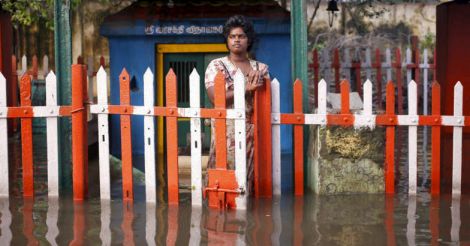Even as the environmental negotiators were debating the dangers of climate change in Paris, the city of Chennai(formerly Madras), the capital of the southern Indian state of Tamil Nadu, reeled under the onslaught of the heaviest rainfall in 104 years.
The city, where 5 million live, virtually shut down, with roads flooded; nearly 5000 homes, train tracks and airport runways engulfed under water; the airport closed, with water the terminal’s main concourse and aircraft marooned; train services suspended; power and phone lines disrupted; and patients dying in hospitals as their respirators, ventilators and oxygen tents failed. More than 260 people lost their lives in the disaster.
It is difficult to imagine the scale of the disruption that brought India’s fourth-largest city to a halt – schools, colleges, IT companies, factories and commercial establishments closed. Fvictims had to be rescued in boats, with India’s army and air force coming to the rescue.
Since the area aroundhosts facilities for a range of global automakers, multinational companies such as Ford, Daimler, BMW and Renault took the unprecedented decision to halt production at their local factories. The venerable newspaper The Hindu failed for the first time in 178 years to bring out a print edition since its employees couldn’t get to work, though it gamely issued one online.
Inevitably, many linked theParis, seeing the dramatic rains as procatastrophic consequences of human action upon the world’s weather. More such disasters, they suggested, are inevitable unless world leaders in Paris take decisive action to limit global climate change.
“We are feeling climate change’s fast growing impact now,” said India’s Prime Minister Narendra Modi, pointing to Chennai and calling upon industrialised nations to do more to reverse global warming.
Scientists predict that India will become significantly hotter over the next few decades, and therefore more prone to a range of weather-related calamities like droughts,, crop failures and cyclones. Chennai, they say, is just the trailer.
And yet there is another factor that arguably offers a more proximate explanation for what went wrong than the long-distance perils of climate change.
It is normal for India’s east coast aroundto suffer heavy monsoon rains at this time of year, though this is the highest recorded since 1911. The flooding was caused not only by the unprecedented levels of rainfall, but also by human acts of omission and commission in the irresponsible and unplanned urbanisation that has transformed India in recent decades.
Virtually, all of the flood-hit areas can be linked to ill-planned construction, which has taken place without regard to hydrology or respect for Chennai’s natural ecosystems.
While norms have been proclaimed by the Environment Department of Tamil Nadu state, they have largely been ignored, since politicians make common cause with builders in the name of development. Airports and bus terminals have been built on floodplains, homes and factories on wetlands and marshlands; even lakes have been dried up for housing projects. Drainage courses and catchments have been fair game for developers. Bypass roads and expressways have sprouted without heeding data on water flow in the city.
A rapid erosion of water bodies has resulted. Since construction has occurred with scant regard for the provision of adequate waste disposal and sewerage systems, the city’s rivers and canals have become garbage dumps, so choked with sewage that they could no longer serve as effective conduits for rainwater to run off to the sea. The destruction of critical wetlands and inadequate infrastructure to contain flood waters meant they could no longer serve as the channels through which the flood water should have drained out.
The same phenomena can be found in dozens of Indian cities. Urbanisation is inevitable: a country of 1.2 billion cannot meaningfully absorb two-thirds of its population in agriculture, and rural people will inevitably move to cities in quest of work and better lives. India’s urban population has risen from 10% at the time of Independence less than seven decades ago to almost 40% today. It will not be long before a majority of Indians live in cities. They cannot all grow the same way as Chennai has.
Many Indian cities have a greater population density than Chennai, and a similar catastrophe in Kochi or Thiruvananthapuram, where I write these words, may lead to much higher casualties. We need to revisit our city drainage systems, rework our disaster management structures and ensure that monsoon rain water can drain out of our cities in the shortest possible time.
The Chennai tragedy is a wake-up call to India. The disaster could have been avoided if stern measures had been taken to preserve water bodies and respect geo-natural imperatives. We must now take the commitment to “sustainable development” that world leaders have just made in New York seriously. If we get our priorities right, we will heed the lessons of this horror and work towards sustainable urban development, expanding and building urban spaces only in ways that respect our environment. If we see Chennai as a one-off event, an ”act of God” rather than an error of Man, further disasters will happen.
The issue is particularly urgent for us in Kerala. Geographically, Thiruvananthapuram and Kochi have many similarities to Chennai. Thiruvananthapuram and Kochi are better planned cities, but dangers do lurk. Our population density is much higher, and a similar catastrophe in Kochi may lead to much higher casualties.
We need to revisit our city drainage systems, rework our disaster management systems and ensure that rain water can drain out of the city in shortest possible time. Of course, Thiruvananthapuram took a giant stride in that way with Operation Anantha, when last year a massive clean-up was undertaken to clean the canals and evacuate the encroachments. Here are our urgent priorities:
Readiness
The first step is to check whether we are ready to tackle such a disaster. Are our drains enough to carry the storm waters out of the city and ultimately into the Arabian Sea? Are these drains clog-free and properly covered? Why do low lying areas like Karamana and Thampanoor constantly get affected in rains, and what can we do to create a permanent solution?
Education and Awareness
Are our people educated and aware about the importance of drainage systems and do they know what to do in case of a calamity like this? Can we educate them on the importance of proper garbage disposal and proper and regulated constructions? Can we include them in Disaster Management Drills? Can we have ward-wise or locality-wise awareness programs on these aspects, which affect all of us?
Disaster Management Systems
Have we updated our Disaster Management Systems? Do our fire and police personnel have the latest equipment as well as training? Can we involve corporates by asking them to train their staff as well as contribute to the program as a whole from their CSR funds? Protecting wetlands
Can we look at stronger implementation of zoning and other regulations? How can we enhance the capacity of our water bodies? Can we have programs to encourage planting of more and more trees?
The Government has made a compelling slogan out of “Make in India”. India is planning the construction of a hundred “smart cities” to bring hi-tech growth to urban centers. They must be smart in a low-tech sense too. The lesson of Chennai is that we cannot let more construction, urbanisation and manufacturing erode our natural resilience to familiar monsoon weather events. We cannot risk Make in India becoming the unmaking of India.
Let us not say we were not warned.


























Disclaimer
The comments posted here/below/in the given space are not on behalf of Manorama. The person posting the comment will be in sole ownership of its responsibility. According to the central government's IT rules, obscene or offensive statement made against a person, religion, community or nation is a punishable offense, and legal action would be taken against people who indulge in such activities.